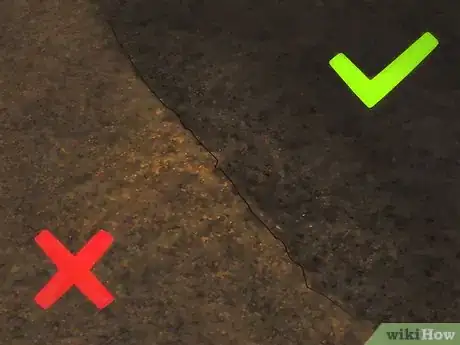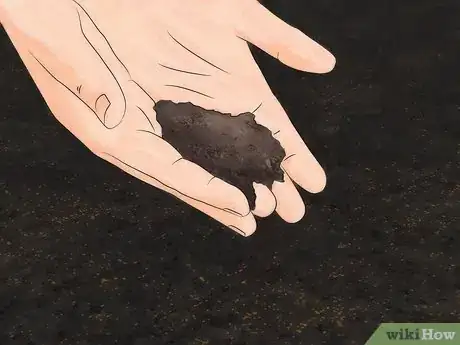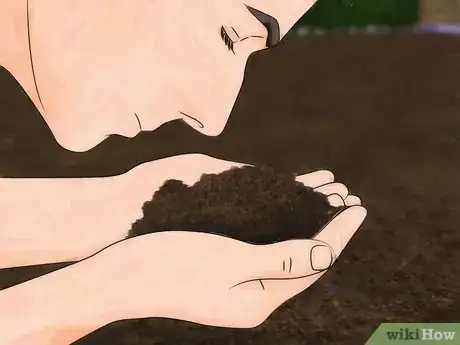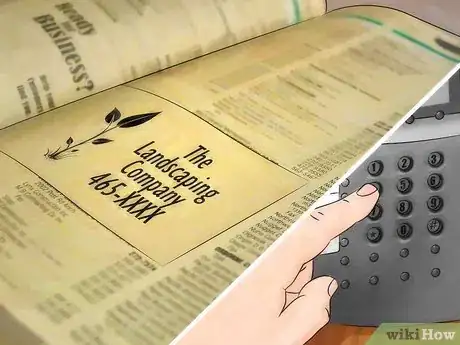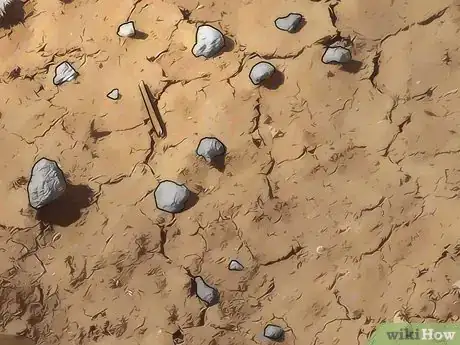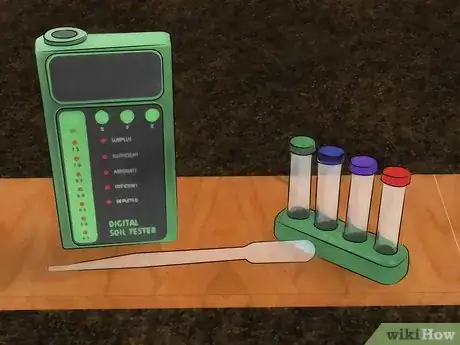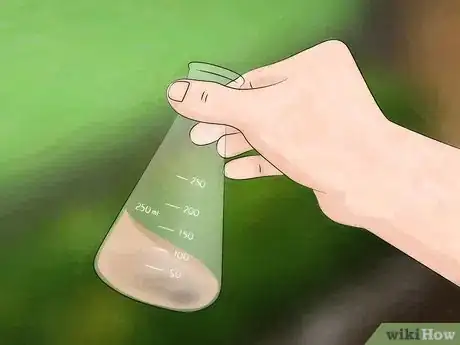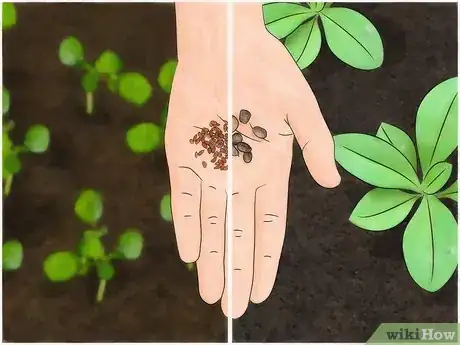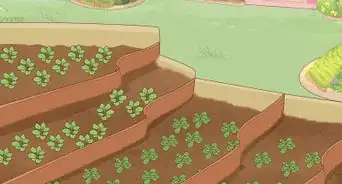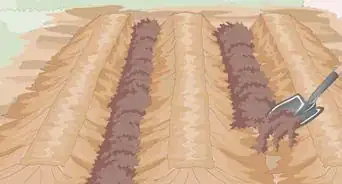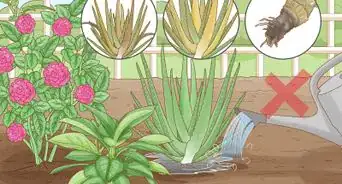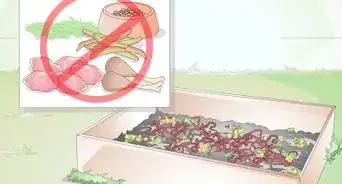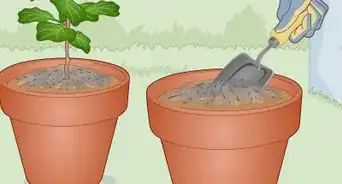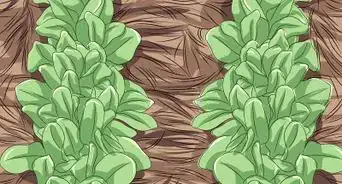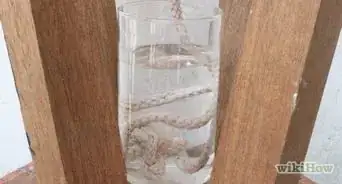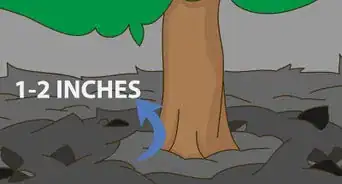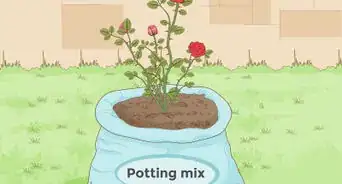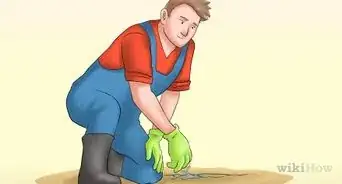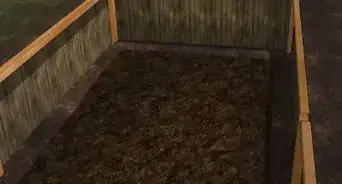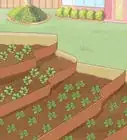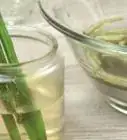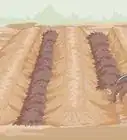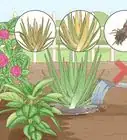This article was co-authored by Lauren Kurtz. Lauren Kurtz is a Naturalist and Horticultural Specialist. Lauren has worked for Aurora, Colorado managing the Water-Wise Garden at Aurora Municipal Center for the Water Conservation Department. She earned a BA in Environmental and Sustainability Studies from Western Michigan University in 2014.
There are 8 references cited in this article, which can be found at the bottom of the page.
This article has been viewed 58,569 times.
Topsoil is the top 6 - 12 inches of soil found in many gardens and lawns. Good topsoil should be nutrient and mineral rich and promote the growth of plants in your lawn or garden. Topsoil is the layer on top of the subsoil, and it sometimes differs because it has a high amount of organic matter, is nutrient rich, and has low salts. When looking for good topsoil there are a number of things that you can do to ensure its quality before committing to a final purchase.
Steps
Examining The Soil
-
1Look for a darker tone in the soil. The more organic material in your soil, the better chance your plants are going to thrive.Topsoil that is too light in color is lacking this material, and will impede the growth of any plants or food that you are trying to plant. In addition, check the surface of the soil for a light or white residue that may indicate the presence of salts or lime, which are both chemicals that can have toxic effects on a garden or lawn.[1]
- Extremely black topsoil indicates a lack of minerals in your soil. Look for something that’s dark brown, but not black.[2]
- If the topsoil you want to buy has already been packaged, ask the owner if he has any sample soil you can look at.
- If the soil is blue-green or gray, it means it’s been continuously wet or saturated which is not good for topsoil. Avoid buying soil that looks like this.
-
2Touch the soil to make sure that it’s crumbly and has a good texture. A quick run of your fingers through the soil will give you a good idea of what it’s made up of. Good topsoil should crumble in your fingers. You should feel the grit in it which indicates minerals that are needed for your plants like phosphorus, magnesium, and calcium. Avoid soil that is too hard, as it indicates low organic matter.
- Soil that clumps up into balls or large chunks is too rich in clay.
- Topsoil that is heavy in clay interferes with plant’s ability to aerate and stops water from effectively reaching the plant’s roots.[3]
- Look for large stones or weed roots which are also bad for topsoil.
Advertisement -
3Wet a sample of the soil to see what it’s made of. Ideally your topsoil is going to be a perfect combination of silt, clay, and sand. Place a portion of wet soil in the palm of your hand. Rub the sand around and pour a little more water over it while it's in your hand. As the sand becomes wet, you can physically feel for its properties. Gritty soil indicates high sand, smoothness indicates high silt, and stickiness indicates high clay. The sand should be dark and posses a combination of stickiness, grittiness, and smoothness. Ideally you don’t want any one element dominating your topsoil. It should be an equal combination of all three.[4]
- You can also see if your soil has any unwanted seeds while doing this.
- If the topsoil you’re examining is not ideal, ask the soil seller if he has anything else available.
-
4Smell the soil and make sure that it smells sweet. Good topsoil will smell sweet. Avoid any soils that have an off-odor or smell like chemicals such as gasoline. This indicates unwanted and unnatural chemicals which can stop plants from growing, and makes for terrible topsoil.[5]
- Topsoil takes hundreds of years to be created naturally, and decomposition should have already taken place. If the soil in question smells like rotting material, stay clear of it.[6]
Asking Questions To The Soil Seller
-
1Determine different locations that sell soil. There are a number of different locations that you can buy topsoil, like home and gardening department stores, or sometimes you can buy it in bulk from a landscaping company. However, the very best place to get topsoil is at your local cooperative extension, which is sponsored by the US Department of Agriculture.[7] Most of these extensions exist at local universities and specialize in creating the best topsoil with the highest nutrient count.
- When you buy topsoil at a chain department store be careful because they often sell a wide variety of different soil for different purposes.
- If you need to buy topsoil in bulk, sometimes the seller will have delivery options available for you.
-
2Ask the seller if they can give you a recipe of the soil makeup. Ideal topsoil is a mixture of sand, silt, and clay. Percentages vary depending on what gardener you talk to, but typically you’ll want something close to 40%-65% sand, 20%-60% silt, and 5%-20% clay. This combination of elements in soil is sometimes referred to as loam, and is the ideal combination for most topsoil.[8] The seller can sometimes provide this recipe and save you the trouble of determining it yourself.
- Remember to look at reviews to see the seller's reputation.
- You can purchase topsoil in bulk at a nearby nursery, landscape supply company, or a home and garden store.
- If you are buying the soil pre-bagged, sometimes the recipe is on the side of the bag.
-
3Ask the seller if the topsoil has been screened. You want pulverized or screened topsoil so that the majority of rocks, unwanted debris, and weeds are removed. Almost no topsoil is going to have a 100% guaranteed weed free blend, however, there are machines that can get most of the weeds out of your topsoil.[9]
- Weeds will impair the growth of your garden or lawn, and screening will save you time in the future from having to de-weed your garden.
- Screening or pulverization also gives your topsoil a more consistent texture.
- If you want to save money, you can screen your own topsoil for unwanted material and debris, however removing unwanted seeds will be more difficult.
-
4Ask to get the soil’s test data. Sometimes people who sell soil, or the manufacturers will have test data available that will inform you of its nutrient makeup and pH level. Having this information at the time of sale will save you time and money from having to test the soil yourself. This is different than the recipe and includes valuable information about the different chemicals in your soil.
- Avoid soils with a pH value less than 4.5 or greater than 7.0 because these levels are not ideal for growing most plants.[10]
- Soluble salts absorb water and prevent it from getting to your plant's roots. Ideal topsoil should have less than 0.5 mmhos/cm for soluble salts test performed using a 1:2 soil:water ratio.
Testing the Soil
-
1Buy a soil test kit at a hardware store to determine its chemical composition. Make sure to buy a kit that tests for nitrogen, phosphorous, potassium and pH level. Mix in water, soil, and your reactive agent per the instructions on the kit, and see if the topsoil you plan on buying has adequate levels for what you are trying to grow. Nitrogen promotes plant growth and produces chlorophyll, Phosphorus promotes root, fruit, flower, and seed production, and potassium regulates water intake and the movement of sugars within a plant.[11]
- Different plants and vegetables require different nutrients. Base your levels of nutrients on your plant types.
- It should give you descriptions for appropriate nutrient and mineral levels in the instructions of your test.
- Sometimes take-home soil test kits are not totally accurate so make sure to read reviews on the brand you are buying.
-
2Take a sample of soil to an cooperative extension for testing. Cooperative extensions exist all over the country to help aspiring farmers or gardeners promote the growth of their crops and gardens.[12] Taking your soil to these professionals will provide you with the most accurate results on the nutrient and mineral makeup of your topsoil.
- Cooperative extensions can also provide you with expert knowledge on how to improve growing your crops.
- They may also direct you to topsoil retailers and distributors that may help reduce your costs.
-
3Try planting different kinds of seeds in the soil to see if they grow. If you don’t want to mess around with chemical and nutrient compositions, a more traditional approach may work for you. Get a sample of the soil before purchasing it in bulk and try to plant whatever intended seeds you’d like to grow. It will take more time, but will allow you to see what kind of topsoil you would be purchasing and if it fits your needs.
- Different plants require different minerals and nutrients so make sure to remember to plant a variety of seeds.
- You can use a couple of samples of topsoil simultaneously so that you can choose the best one.
Expert Q&A
-
QuestionWhat is organic topsoil?
 Maggie MoranMaggie Moran is a Professional Gardener in Pennsylvania.
Maggie MoranMaggie Moran is a Professional Gardener in Pennsylvania.
Home & Garden Specialist Organic topsoil is a thin layer at the top of the soil and is made of organic materials.
Organic topsoil is a thin layer at the top of the soil and is made of organic materials. -
QuestionWhat does the topsoil do?
 Maggie MoranMaggie Moran is a Professional Gardener in Pennsylvania.
Maggie MoranMaggie Moran is a Professional Gardener in Pennsylvania.
Home & Garden Specialist Since the topsoil is where plants have lived, died, and decomposed for thousands of years, it is the perfect place to plant crops and flowers.
Since the topsoil is where plants have lived, died, and decomposed for thousands of years, it is the perfect place to plant crops and flowers. -
QuestionCan topsoil be used for planting?
 Maggie MoranMaggie Moran is a Professional Gardener in Pennsylvania.
Maggie MoranMaggie Moran is a Professional Gardener in Pennsylvania.
Home & Garden Specialist Yes, it is great for planting in the ground and holds a great number of nutrients.
Yes, it is great for planting in the ground and holds a great number of nutrients.
References
- ↑ http://extension.usu.edu/files/publications/publication/AG-SO-02.pdf
- ↑ http://msue.anr.msu.edu/news/the_shocking_truth_about_topsoil
- ↑ http://homeguides.sfgate.com/difference-between-garden-soil-top-soil-31708.html
- ↑ http://extension.usu.edu/files/publications/publication/AG-SO-02.pdf
- ↑ https://extension.unh.edu/resources/files/Resource000492_Rep514.pdf
- ↑ https://extension.unh.edu/resources/files/Resource000492_Rep514.pdf
- ↑ https://nifa.usda.gov/extension
- ↑ http://njaes.rutgers.edu/pubs/plantandpestadvisory/1996/ln0328.pdf
- ↑ http://articles.latimes.com/1989-09-17/realestate/re-97_1_soil-amendment
